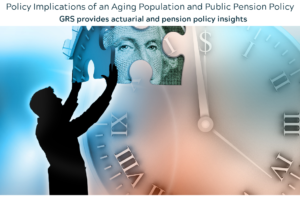Events
July 31, 2019
Paul Wood Provides Insights on an Aging Population and Public Pension Policy
 Paul Wood, ASA, FCA, MAAA was interviewed by Leigh Snell, NCTR’s Director of Federal Relations for a webinar, held on July 31, 2019, discussing the policy challenges associated with an aging public sector workforce and retiree population. Paul provided the audience with insights on the new mortality tables, funding impact, actuarial assumption revisions, and emerging plan design trends. If you would like to learn more about this topic, please contact Paul at paul.wood@grsconsulting.com.
Paul Wood, ASA, FCA, MAAA was interviewed by Leigh Snell, NCTR’s Director of Federal Relations for a webinar, held on July 31, 2019, discussing the policy challenges associated with an aging public sector workforce and retiree population. Paul provided the audience with insights on the new mortality tables, funding impact, actuarial assumption revisions, and emerging plan design trends. If you would like to learn more about this topic, please contact Paul at paul.wood@grsconsulting.com.
